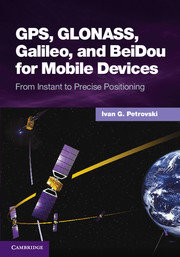Book contents
- Frontmatter
- Contents
- Foreword by Glen Gibbons
- About this book
- Acknowledgments
- List of abbreviations and acronyms
- List of definitions
- Part I GNSS: orbits, signals, and methods
- 1 GNSS ground and space segments
- 2 GPS, GLONASS, Galileo, and BeiDou signals
- 3 Standalone positioning with GNSS
- 4 Referenced positioning with GNSS
- Part II From conventional to software GNSS receivers and back
- Part III Mobile positioning at present and in the future
- Part IV Testing mobile devices
- Index
- References
3 - Standalone positioning with GNSS
from Part I - GNSS: orbits, signals, and methods
Published online by Cambridge University Press: 05 May 2014
- Frontmatter
- Contents
- Foreword by Glen Gibbons
- About this book
- Acknowledgments
- List of abbreviations and acronyms
- List of definitions
- Part I GNSS: orbits, signals, and methods
- 1 GNSS ground and space segments
- 2 GPS, GLONASS, Galileo, and BeiDou signals
- 3 Standalone positioning with GNSS
- 4 Referenced positioning with GNSS
- Part II From conventional to software GNSS receivers and back
- Part III Mobile positioning at present and in the future
- Part IV Testing mobile devices
- Index
- References
Summary
The Global Navigation Satellite System comprises a constellation of satellites and a ground segment that determines the satellite coordinates. The main idea behind GNSS is to measure distances between satellites and users located on the surface of the Earth or in the lower atmosphere.
Satellites move around the Earth along precisely known orbits, so we can define a satellite’s position precisely at any given moment. GNSS satellites transmit signals on frequencies between 1 and 2 GHz. These signals can be received by using a GNSS receiver. When the receiver acquires the satellite signal, the user can estimate the time required for the signal to propagate to the user from the satellite. By referring to information about satellite orbits and measured distances to the satellites, a user can calculate receiver position as an intersection of four spheres in the four-dimensional space-time continuum. If the receiver time could be perfectly synchronized with the system or satellite time frame, only three satellites would be required to determine receiver position in three-dimensional space (Figure 3.1).
- Type
- Chapter
- Information
- GPS, GLONASS, Galileo, and BeiDou for Mobile DevicesFrom Instant to Precise Positioning, pp. 88 - 109Publisher: Cambridge University PressPrint publication year: 2014
References
- 2
- Cited by



